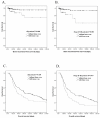Is there a role of whole-body bone scan in patients with esophageal squamous cell carcinoma
- PMID: 22853826
- PMCID: PMC3443043
- DOI: 10.1186/1471-2407-12-328
Is there a role of whole-body bone scan in patients with esophageal squamous cell carcinoma
Abstract
Background: Correct detection of bone metastases in patients with esophageal squamous cell carcinoma is pivotal for prognosis and selection of an appropriate treatment regimen. Whole-body bone scan for staging is not routinely recommended in patients with esophageal squamous cell carcinoma. The aim of this study was to investigate the role of bone scan in detecting bone metastases in patients with esophageal squamous cell carcinoma.
Methods: We retrospectively evaluated the radiographic and scintigraphic images of 360 esophageal squamous cell carcinoma patients between 1999 and 2008. Of these 360 patients, 288 patients received bone scan during pretreatment staging, and sensitivity, specificity, positive predictive value, and negative predictive value of bone scan were determined. Of these 360 patients, surgery was performed in 161 patients including 119 patients with preoperative bone scan and 42 patients without preoperative bone scan. Among these 161 patients receiving surgery, 133 patients had stages II + III disease, including 99 patients with preoperative bone scan and 34 patients without preoperative bone scan. Bone recurrence-free survival and overall survival were compared in all 161 patients and 133 stages II + III patients, respectively.
Results: The diagnostic performance for bone metastasis was as follows: sensitivity, 80%; specificity, 90.1%; positive predictive value, 43.5%; and negative predictive value, 97.9%. In all 161 patients receiving surgery, absence of preoperative bone scan was significantly associated with inferior bone recurrence-free survival (P = 0.009, univariately). In multivariate comparison, absence of preoperative bone scan (P = 0.012, odds ratio: 5.053) represented the independent adverse prognosticator for bone recurrence-free survival. In 133 stages II + III patients receiving surgery, absence of preoperative bone scan was significantly associated with inferior bone recurrence-free survival (P = 0.003, univariately) and overall survival (P = 0.037, univariately). In multivariate comparison, absence of preoperative bone scan was independently associated with inferior bone recurrence-free survival (P = 0.009, odds ratio: 5.832) and overall survival (P = 0.029, odds ratio: 1.603).
Conclusions: Absence of preoperative bone scan was significantly associated with inferior bone recurrence-free survival, suggesting that whole-body bone scan should be performed before esophagectomy in patients with esophageal squamous cell carcinoma, especially in patients with advanced stages.
Figures


Similar articles
-
Prognostic role of neutrophil-lymphocyte ratio in operable esophageal squamous cell carcinoma.World J Gastroenterol. 2015 May 14;21(18):5591-7. doi: 10.3748/wjg.v21.i18.5591. World J Gastroenterol. 2015. PMID: 25987784 Free PMC article.
-
Comparison of neoadjuvant chemotherapy versus upfront surgery with or without chemotherapy for patients with clinical stage III esophageal squamous cell carcinoma.Dis Esophagus. 2017 Feb 1;30(2):1-8. doi: 10.1111/dote.12473. Dis Esophagus. 2017. PMID: 26919154
-
Evaluation of the 7th edition of the TNM classification in patients with resected esophageal squamous cell carcinoma.World J Gastroenterol. 2014 Dec 28;20(48):18397-403. doi: 10.3748/wjg.v20.i48.18397. World J Gastroenterol. 2014. PMID: 25561808 Free PMC article.
-
Trimodality treatment versus surgery alone for esophageal cancer. A stratified analysis with minimally invasive pretreatment staging.J Cardiovasc Surg (Torino). 2002 Aug;43(4):531-7. J Cardiovasc Surg (Torino). 2002. PMID: 12124569
-
Clinical significance of plasma fibrinogen level as a predictive marker for postoperative recurrence of esophageal squamous cell carcinoma in patients receiving neoadjuvant treatment.Dis Esophagus. 2014 Sep-Oct;27(7):654-61. doi: 10.1111/dote.12115. Epub 2013 Aug 27. Dis Esophagus. 2014. PMID: 23980622
Cited by
-
Analysis of Homogeneous and Heterogeneous Factors for Bone Metastasis in Esophageal Cancer.Med Sci Monit. 2019 Dec 10;25:9416-9425. doi: 10.12659/MSM.920483. Med Sci Monit. 2019. PMID: 31821313 Free PMC article.
-
Predictive Role of Elevated Neutrophil-Lymphocyte Ratio for Bone Metastasis in Esophageal Cancer.Technol Cancer Res Treat. 2024 Jan-Dec;23:15330338241272043. doi: 10.1177/15330338241272043. Technol Cancer Res Treat. 2024. PMID: 39149934 Free PMC article.
-
99m Tc bone scintigraphy does not affect preoperative workup for patients with potentially resectable esophageal squamous cell carcinoma.Thorac Cancer. 2022 Aug;13(16):2371-2376. doi: 10.1111/1759-7714.14575. Epub 2022 Jul 10. Thorac Cancer. 2022. PMID: 35811377 Free PMC article. Clinical Trial.
References
-
- Estes NC, Stauffer J, Romberg M, Thomas JH, Jewell WR, Hermreck A. Squamous cell carcinoma of the esophagus. Am. 1996;62:573–576. - PubMed
-
- Dresner SM, Wayman J, Shenfine J, Harris A, Hayes N, Griffin SM. Pattern of recurrence following subtotal oesophagectomy with two field lymphadenectomy. Br. 2000;87:362–373. - PubMed
Publication types
MeSH terms
LinkOut - more resources
Full Text Sources
Medical

